Contents The Bhagavad G t
t comes to us from sacred India. Its verses of ancient wisdom on the mysteries of human existence speak to us today as if they had just been spoken. The Bhagavad G
comes to us from sacred India. Its verses of ancient wisdom on the mysteries of human existence speak to us today as if they had just been spoken. The Bhagavad G t
t is one of the most loved works among the collections of scriptural texts found within the Hindu traditions. It also stands out among the holy books of the major world religions, for its flowing Sanskrit verses present a uniquely vivid portrait of the intimacy between humanity and divinity. Indeed, this divine intimacy is revealed in the form of a dialogue that takes the soul on an inward journey culminating in the ultimate state of yoga, in which souls unite with the heart of God. The Bhagavad G
is one of the most loved works among the collections of scriptural texts found within the Hindu traditions. It also stands out among the holy books of the major world religions, for its flowing Sanskrit verses present a uniquely vivid portrait of the intimacy between humanity and divinity. Indeed, this divine intimacy is revealed in the form of a dialogue that takes the soul on an inward journey culminating in the ultimate state of yoga, in which souls unite with the heart of God. The Bhagavad G t
t , often called simply the G
, often called simply the G t
t , Bhagavad G
, Bhagavad G t
t may be translated as the song of the Beloved Lord, which conveys a divine yearning.
may be translated as the song of the Beloved Lord, which conveys a divine yearning.
The word Bhagavad means song, in this case one coming from Krishna or God. Clearly the text is a philosophical poem and not a song in the literal sense. At a deeper level, however, it is a song issuing forth from the heart of God. It is the secret call of the divinity for all souls to love him, to take the journey to him, to be blissfully united with him. Although India is the birthplace of a variety of religious traditions, including Buddhism, Jainism, and Sikhism, it is Hinduism that is the dominant religion in India today. Hinduism is composed of several primary and numerous less familiar traditions, all theologically distinctive, yet each acknowledging the revelational authority of a common ancient scriptural source.
Possibly the oldest sacred text in the world, dating as far back as 2500 to 1500 BCE , the collection of Sanskrit hymns known as the Vedas are foundational for the myriad traditions that come under the umbrella of Hinduism. These traditions make up the largest constituency of religious practitioners in South Asia. Among these, the traditions that focus upon the supreme divinity of Krishna or his cosmic manifestation of Vishnu are known as Vaishnava, and they constitute the dominant form of religion. The Bhagavad G t
t comes to us from this Vaishnava tradition, which is present throughout India and, in the second half of the twentieth century, around the globe. This beloved book of India is often called the bible of Hinduism in the West. As the Bible is for Christians and the Quran for Muslims, so it could be said that the Bhagavad G
comes to us from this Vaishnava tradition, which is present throughout India and, in the second half of the twentieth century, around the globe. This beloved book of India is often called the bible of Hinduism in the West. As the Bible is for Christians and the Quran for Muslims, so it could be said that the Bhagavad G t
t is for Hindus, for it is the single most influential philosophical sacred text coming from South Asia.
is for Hindus, for it is the single most influential philosophical sacred text coming from South Asia.
Though it is, since the seventh century, the most widely read and commented on holy text in all of India, it comes from a tradition that reveres many sacred texts, unlike Western religious traditions, which focus on one sacred book of revelation. Moreover, though the Bhagavad G t
t is usually read alone, it is a small section of a substantially larger text, perhaps the largest epic poem in the world, the Mah
is usually read alone, it is a small section of a substantially larger text, perhaps the largest epic poem in the world, the Mah bh
bh rata. The philosophical verses of the G
rata. The philosophical verses of the G t
t stand gracefully as an autonomous text with a beginning, middle, and end, despite their original placement within the continuum of this greater epic poem. The Mah
stand gracefully as an autonomous text with a beginning, middle, and end, despite their original placement within the continuum of this greater epic poem. The Mah bh
bh rata, containing approximately 100,000 verses, is thought by Western scholars to have appeared in its final form sometime between 500 BCE and 200 CE , though traditional dating of events in the text places them in the third millennium BCE . The eighteen chapters of the G
rata, containing approximately 100,000 verses, is thought by Western scholars to have appeared in its final form sometime between 500 BCE and 200 CE , though traditional dating of events in the text places them in the third millennium BCE . The eighteen chapters of the G t
t appear as chapters 23 through 40 in the Book of Bh
appear as chapters 23 through 40 in the Book of Bh shma, the sixth of the Mah
shma, the sixth of the Mah bh
bh ratas eighteen books. Historically, we first come to know of the divinity of Krishna in the Bhagavad G
ratas eighteen books. Historically, we first come to know of the divinity of Krishna in the Bhagavad G t
t text.
text.
Although his identity as the divine lover is not revealed in the G t
t , Krishna is traditionally appreciated as the divinity who sends out a love call to all souls. His call is intended for those who relate to him in loving intimacy, not for those who regard him with reverential awe, worshipping primarily his attributes of cosmic power and majesty. As the supreme divinity, Krishna plays multiple roles, adopts a variety of personae, and displays numerous grand and cosmic manifestations, yet he is also delightfully playful and personal. The various roles that Krishna assumes in his more intimate acts, particularly as a youthful cowherd, are considered the most exquisite, revealing endearing and beautiful visions of the supreme. Most enchanting and charming, Krishna is loved and worshipped by Hindus in a variety of forms: as a sweet but mischievous child, as the closest friend, or even as the ultimate lover. In these intimate relationships with the divinity, Krishna, famous for his divine love call, sends forth his call by producing captivating music on his flute.
, Krishna is traditionally appreciated as the divinity who sends out a love call to all souls. His call is intended for those who relate to him in loving intimacy, not for those who regard him with reverential awe, worshipping primarily his attributes of cosmic power and majesty. As the supreme divinity, Krishna plays multiple roles, adopts a variety of personae, and displays numerous grand and cosmic manifestations, yet he is also delightfully playful and personal. The various roles that Krishna assumes in his more intimate acts, particularly as a youthful cowherd, are considered the most exquisite, revealing endearing and beautiful visions of the supreme. Most enchanting and charming, Krishna is loved and worshipped by Hindus in a variety of forms: as a sweet but mischievous child, as the closest friend, or even as the ultimate lover. In these intimate relationships with the divinity, Krishna, famous for his divine love call, sends forth his call by producing captivating music on his flute.
He is best known for alluring the lovely cowherd maidens of the paradisal village of Vraja out of their homes, one serene autumn evening. Upon hearing his irresistibly sweet flute music, the maidens abruptly abandon their families and household duties to join him in the moonlit forest. On this sanctified night, the maidens and Krishna enact the famous R sa L
sa L l
l , which I have broadly translated as the dance of divine love. In the Bhagavad G
, which I have broadly translated as the dance of divine love. In the Bhagavad G
Next page
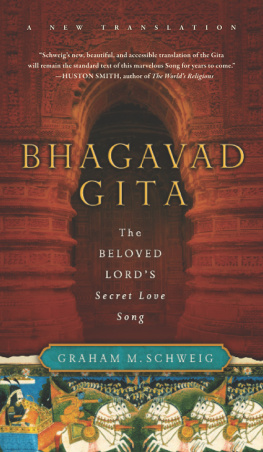


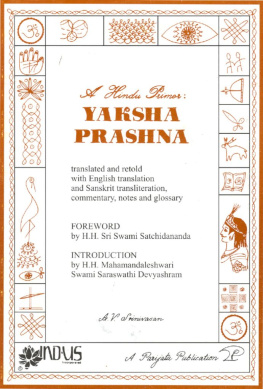
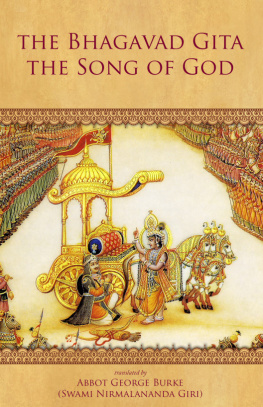
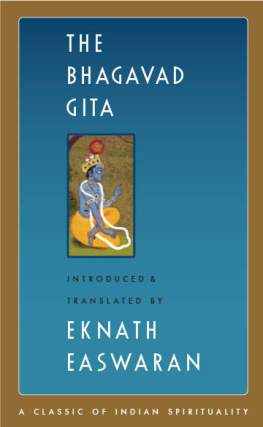
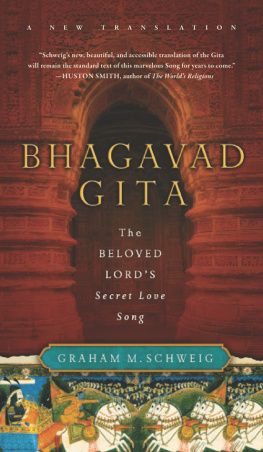
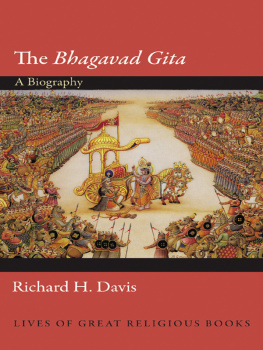
 t
t comes to us from sacred India. Its verses of ancient wisdom on the mysteries of human existence speak to us today as if they had just been spoken. The Bhagavad G
comes to us from sacred India. Its verses of ancient wisdom on the mysteries of human existence speak to us today as if they had just been spoken. The Bhagavad G t
t may be translated as the song of the Beloved Lord, which conveys a divine yearning.
may be translated as the song of the Beloved Lord, which conveys a divine yearning.